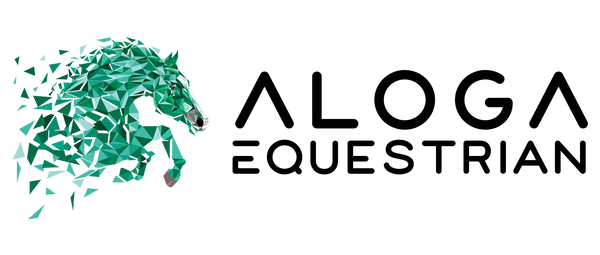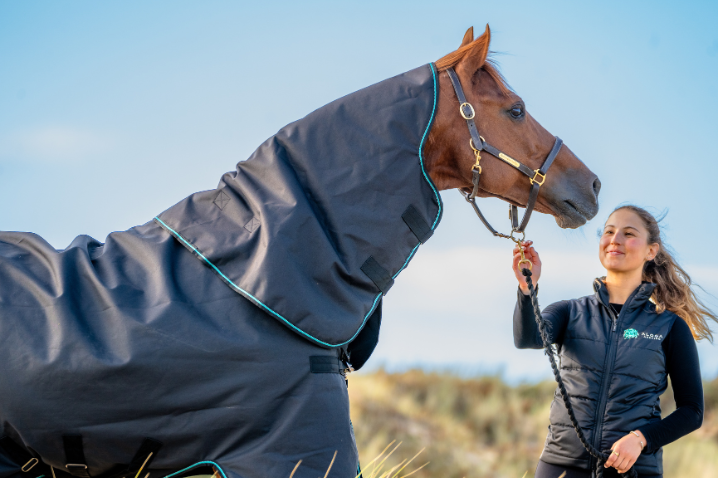Whether searching for a turnout or a cooler, choosing the right size blanket is essential to ensuring comfortable protection for your horse. Our step-by-step guide takes the guess work out of sizing your horse for their Aloga blanket.
Here’s how:
1.Measuring Your Horse Correctly for their new blanket
Using a soft measuring tape or a piece of string start at the centre of your horse’s chest. Run the tape along their side making sure to include their shoulder before finishing at the centre point of the tail.

If you are using string to measure mark the end point before comparing the length to a measuring tape to find the length in cms or inches. Once the overall length has been determined remove 10cm or 4 inches from this measurement to get the finished length.

Then compare the finished length to the Aloga Blanket size chart to find your horse’s correct size.

WHY MEASURE TO THE CENTRE OF THE TAIL?
The Aloga blankets are designed to finish along the end of the hind quarters however when measuring it can be difficult to get a fixed point on this area that is consistent with every horse’s body shape. Measuring to the centre of the tail is an easy to determine point that can be found regardless of horses’ different shapes and sizes. We remove 4 inches or 10cm because your Aloga blanket will not finish at the centre of the tail – removing these from the overall length will give you the correct finishing point to ensure the ideal fit of your horse’s Aloga blanket.

2. Ensure everything is sitting right
A correctly fitting blanket should cover your horse comfortably without restricting movement. Depending on the front closure of the blanket that you chose, checking it positioning can help ensure your blanket is fitting properly.
Double Front Closure: To check your Aloga blanket with a Double Front closure is properly fitted the top strap of this closure style should sit in line with your horse’s point of shoulder. This can be checked by running your hand firmly from the centre of the top strap along your horse’s shoulder until you feel the protruding, bony section of the shoulder. If this strap is sitting lower or higher than the point of shoulder the blanket is not sitting correctly and will not be comfortable for your horse.

Pro Front Closure: To check your Aloga blanket with a Pro Front closure is sitting correcting the lower straight strap of this closure style should be sitting in line with your horse’s point of shoulder. This can be checked by running your hand firmly from the centre of the top strap along your horse’s shoulder until you feel the protruding, bony section of the shoulder. If this strap is sitting lower or higher than the point of shoulder the blanket is not sitting correctly and will not be comfortable for your horse.

The next easy to do check is ensuring you can comfortably run a flat hand along the inside of the neck of the blanket from chest to withers. The neck of the blanket should sit flat and comfortably over your hand. If there is any tension or areas that are tight against your hand the blanket might be too tight and could cause potential rubbing.
3. Secure those straps
Surcingles (straps) on all Aloga blankets are adjustable to ensure a secure fit. To make sure your blanket’s surcingles are ‘just right’ use the adjustable runner to shorten or lengthen the straps. To establish the correct surcingle fit you should be able to fit a vertical palm’s width between your horse’s belly and the surcingles. Surcingles that are too tight pose the risk of rubbing while those that are to lose may be a safety hazard and at risk of getting caught up.
PRO TIP: Check surcingles of your horse’s Aloga blanket at regular weekly intervals – surcingles can ease out over time and changes in your horse’s weight can also affect how they fit.
Good to Go!
Choosing the right size blanket for your horse isn’t just about comfort—it’s also about safety. An ill-fitting blanket can cause issued such as skin rubs or even injury if it slips. Take the time to measure carefully and adjust the fit as needed. Be sure to monitor any physical changes in your horse as exercise or feeding routines change throughout the season.

